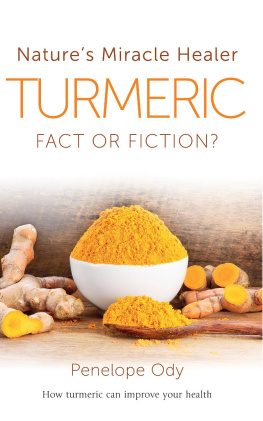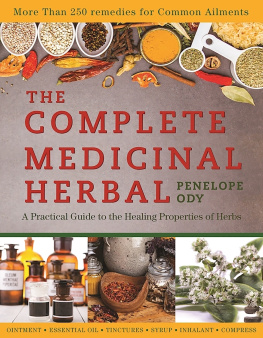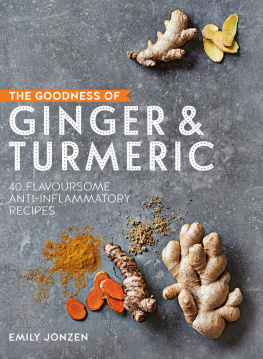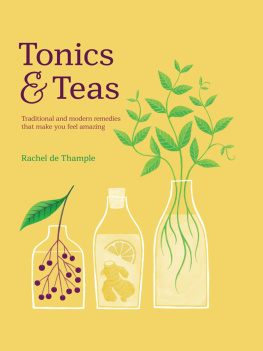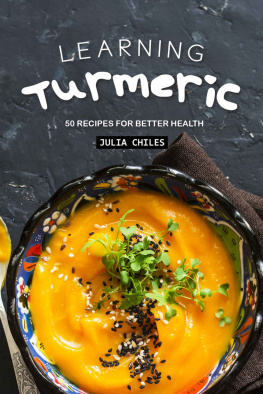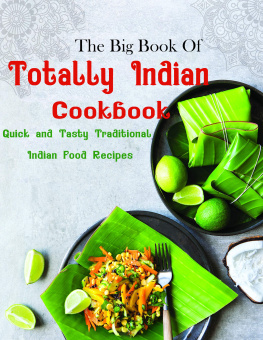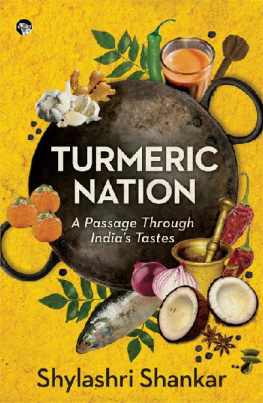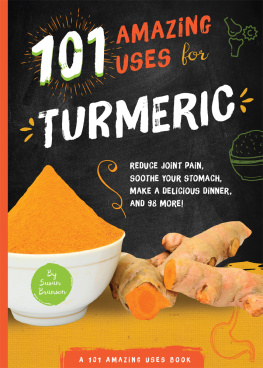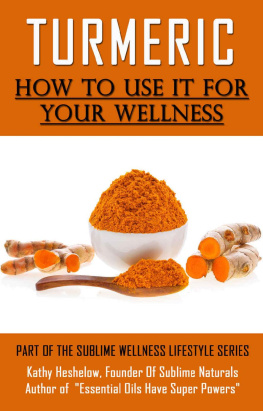The aim of this book is to provide a balanced view of the potential medical applications of turmeric and its derivatives in the light of recent research both positive and negative. It neither endorses nor censures any of the commercial products mentioned in its pages. In the UK, products based on turmeric or its derivatives, unless prescribed by a healthcare professional, are sold only as food supplements so cannot claim to deliver any specific medical benefits.
Where health is concerned and in particular for a serious problem of any kind it must be stressed that there is no substitute for seeking advice from a qualified healthcare professional rather than attempting self-medication based on Internet or other sources. It is important, if you are already taking prescribed medication and are considering trying food supplements based on turmeric or its derivatives, that you consult your healthcare practitioner first. If you experience any unexpected symptoms when taking turmeric or its derivatives, it is advisable to stop immediately and seek professional advice.
The Publisher makes no representation, express or implied with regard to the accuracy of the information contained in this book, and legal responsibility or liability cannot be accepted by the Author or Publisher for any errors or omissions that may be made or for any loss, damage, injury or problems suffered in anyway arising from following any advice offered in these pages.
One of those irritating spam e-mails arriving in my in-box just as I began writing this book seemed to sum it all up perfectly: Turmeric a remedy for every kind of human inflammation, [brand name] now brings it to you in a bottle! CURES WHATEVER AILS YOU. If you talk to turmeric fans, theyll tell you it can cure cancer, reduce your risk of disease, and flood your body with life-saving anti-oxidants.
The spam message was typical of the advertising that surrounds many of the turmeric-based remedies sold in health food shops. If even half the marketing hype one reads about turmeric were true it could well fall into the natures miracle category. The question to ask is, of course, just how valid are the numerous claims made for the herb? Traditionally, turmerics medicinal uses have been far more limited than much of the current media hype suggests. If it really achieves half the cures claimed for it, then it would be rather strange if these actions had only become apparent in the past 20 years and had never been noticed during its millennia of use. Perhaps the placebo effect is playing a part with those turmeric fans so convinced of the herbs near-magical properties that the health benefits they perceive are a classic case of mind over matter?
Turmeric particularly its chemical constituents, the curcuminoids, responsible for the yellow colouring has been extensively studied in recent decades. In 2015 a database was established to attempt to keep track of all this research. At the time of writing it lists 10,971 publications on curcumin as well as 962 patents involving the substance.
An extensive review of curcumin chemistry published in 2017 noted that since the late 1990s the number of scientific papers published about curcumin had increased exponentially from around 100 per year to some 1,400 in 2016. Although this study focussed on curcumin chemistry, rather than turmeric as a whole, it noted how any negative studies about the constituent tended to be swept away in the face of a torrent of papers, reviews, patents, and Websites touting the use of curcumin as an anticancer agent, a therapeutic for Alzheimers disease, a treatment for hangovers, erectile dysfunction, baldness, hirsutism, a fertility-boosting and contraceptive extract, collectively establishing the properties expected of a panacea. While the curcuminoids have been the focus of much research, this study raised significant questions as to whether these chemicals really are entirely responsible for turmerics therapeutic properties. Not that this appears to concern the manufacturers of the various curcumin extracts.
Much research into herbs is aimed at identifying key chemical constituents, which can then be individually extracted or replicated synthetically to produce unique drugs. These can be patented and thus become profitable for the companies involved. There is little incentive in researching at considerable expense a whole plant that can then be grown in a back garden or foraged and be used for minimal expense by anyone who wishes to benefit.
A problem with this isolated chemical approach is, of course, that as far as herbs are concerned the whole plant is often greater than the sum if its parts. Examples abound: such as meadowsweet (Filipendula ulmaria) which contains the same chemical as aspirin, but the whole herb is used as a remedy for gastritis, whereas aspirin alone is a significant cause of stomach inflammation; or dandelion leaf (Taraxacum officinale) a potent diuretic that is extremely rich in potassium, which is lost from the body by excessive urination, so the herb is effectively putting back what it is taking out.
We also know very little about how the various chemical constituents of a plant work together to create physiological effects. While the constituents of many herbs have been identified there are often a few that remain unclassified and inevitably the mix varies depending on growing conditions, age of the plant, soil composition and so on. While individual plant constituents can be highly significant as with digoxin and digitoxin from the foxglove when used in isolation these chemicals can have very different therapeutic properties from the whole plant.
The result, seen on any health food store shelf, is that while some manufacturers are happy to sell capsules filled only with turmeric powder, many others prefer to offer a variety of curcuminoid extracts: sometimes just curcumin, sometimes all of the curcuminoids, and sometimes a mixture of curcumin and other herbs or vitamins.
The various curcumin and curcuminoid extracts are produced by a small number of global companies specialising in biotechnology or pharmaceuticals (see liquid extracts available. The various patented products have also been used in many company-sponsored research studies and clinical trials, which are used to support the various claims made by the producers of the final consumer products.
How these manufacturers market the final products varies and can lead to significant confusion in the claims they make and the language they use to promote their products. Because curcumin has poor absorption when taken orally (most is simply excreted) the extract makers have tried various tactics to improve its bioavailability. One website puts its claim for a comparable product rather differently as yields 95% curcuminoids. Yield is entirely different to contains as it implies how much of the curcuminoids present may be available to someone taking the remedy. Some talk of enhancing bioavailability by up to 285 times while others prefer to claim 2000%, which is mathematically confusing.
The various curcuminoid capsules on the market typically contain anything from 20mg to 250mg or more of the designated extract and, typically, two capsules per day are recommended. The amount of curcuminoids in turmeric varies, from about 1% to 6% occasionally more depending on variety and where grown, but generally accepted to average about 4.5%. Given this low and variable content, if the curcuminoids really are the key therapeutic constituents high doses of turmeric would probably have been needed in the past to have any significant affect.

